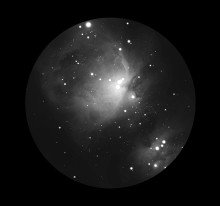Well, Dorset seems to be having another pretty dismal time at the moment, weather-wise, with full-on Autumn rains and high winds. Needless to say, I haven’t been out with the scope for a few weeks now, but that has meant there’s been plenty of time to research and plan my next session … and that usually means using Stellarium* to explore what’s going to be viewable over the next few weeks.
I’m particularly looking forward to scanning around the constellation of Orion, which should be visible in the East from about 10PM. The red supergiant Betelguese (Orion’s right shoulder) is so big that, if it were placed at the centre of our solar system, its surface would extend almost as far as Jupiter! It’s bright orangey-red colour is unmistakeable, and really is striking when viewed through binoculars or a scope. The three stars of Orion’s belt contribute to making this one of the most easily recognised constellations in the night sky. Just to the left of the left-hand star (Alnitak) is the Horsehead nebula – this needs a large aperture telescope and good clear dark skies to see, but even scanning the belt area with binoculars should reveal subtle hints of nebulosity (the interstellar gas and dust from which the stars formed in the first place).
Below the belt stars lies the Great Orion Nebula (Messier 42), one of the most spectacular astronomical objects visible. This is a vast stellar nursery, made up of dense clouds of gas and dust, and is home to several relatively new stars, such as those making up the Trapezium cluster. Although some structure formed by the process of star creation will be visible in binoculars and smaller telescopes, the Orion Nebula is quite simply breathtaking when viewed in a larger aperture scope. The accompanying picture pretty accurately shows how M42 appears in my scope using a lower power, wide field eyepiece (magnification x50).
Pretty much the whole of the Orion constellation contains something called the Orion Molecular Cloud Complex (made up of the Orion Nebula, the Horsehead and Flame nebulae, Messier 43 and 78, and Barnard’s loop). Not all of the complex can be seen in visible light, but nonetheless there’s much that can. There’s enough in this constellation to occupy the visual astronomer for several evenings at least. By trying different magnification eyepieces, and using optical filters, such as OIII and Ultra High Contrast, much detail can be teased out of the clouds of gas and dust. There are lots of amazing images of the Orion Molecular Cloud Complex on the internet; well worth checking out (shame the eye can’t take it all in).
The star at Orion’s left foot is Rigel. At around 200,000 times as bright as our sun, this blue supergiant is one of the brightest stars in the sky. Like the red supergiant Betelguese, Rigel will some day explode as a type 2 supernova (in the case of Betelguese, it’s estimated that this could happen sometime in the next million years). Should make for a spectacular sight.
To the right of Rigel is the dim reflection nebula commonly referred to as the Witch’s head. This is a very large object, though very dim, and you probably stand your best chance of seeing it using binoculars and a very dark clear night.
*I really can’t recommend the Stellarium programme enough. It’s free, works on all computer operating systems, and is perfect for whiling away those evenings when you can’t get out observing : https://stellarium.org
What’s up?
All of the above are certainly on my hit list for November (assuming the cloud, wind and rain ever let up). Other targets for the month include Uranus, to the South, fairly high up, and in the constellation of Pisces. A pair of binoculars should show a clearly non-stellar, greeny-blue disc. A large telescope should be able to pick up the larger moons, too.
If you’re up late enough, look to the East from about 11.30PM. At the heart of the Cancer constellation lies Messier 44, the Beehive cluster. This is a truly magnificent star cluster (between 50-100 stars), and is one of my favourites.
Clear skies!
Kevin Quinn is an amateur astronomer based in Cerne Abbas, he is the proud owner of a ten-inch reflector, a case of eyepieces, and a pair of 20×80 binoculars. He tweets via @CerneAstro, blogs via theastroguy.wordpress.com, and his ebook Demystifying Astronomy – A beginner’s guide to telescopes, eyepieces and accessories for visual astronomy is widely available.
©Kevin Quinn












